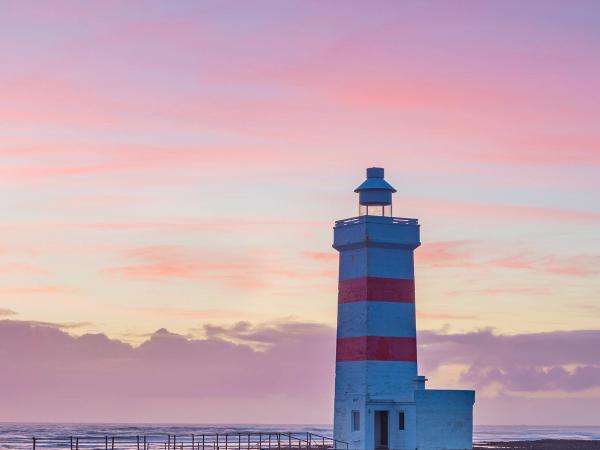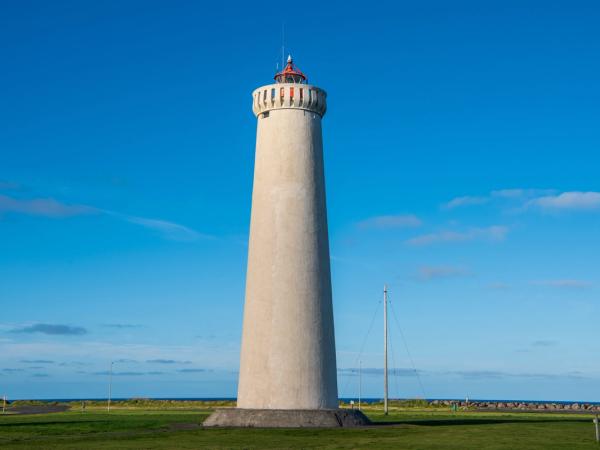
Exploring Iceland’s 11 Best Lighthouses: A campervan guide to these beacons of beauty and adventure
Iceland’s rugged coastline, shaped by volcanic forces and relentless Atlantic waves, has more than 100 lighthouses. They are a testament to the country’s maritime heritage. Also, the location of the island in the middle of the North Atlantic Ocean means that thousands of ships pass close to its coasts every year. And the waters surrounding Iceland are treacherous and can be complicated, especially at night. That’s why there are so many lighthouses here, to help navigation in the area. The Icelandic word for lighthouse is viti, and many of them are located in astonishing locations.
Visiting them can be a great experience, and here we’ve selected some of the best, along with places where you can park your campervan afterwards and spend the night.
Key Takeaways
- Iceland has more than 100 lighthouses along its coastline.
- Some of them are beautiful buildings while others are just beacons to guide maritime travel.
- As camping culture is quite strong in Iceland, there’s always a campsite nearby.
1. Grótta Lighthouse
This is one of the most beautiful and iconic lighthouses in Iceland. It’s just outside Reykjavik, on the westernmost point of the Seltjarnarnes Peninsula. It’s a great location for a quick escape from the capital’s busy streets.
It was built in 1947, and it’s a white tower that contrasts with the dark waters of Faxaflói Bay, with the impressive Mount Esja looming in the distance. The surrounding area is a nature reserve full of seabirds, and many people, both locals and tourists, come to this place to watch the sunset. There’s also a unique bathing experience there, the Kvika Footbath: a small geothermal pool to soak your feet. The path leading to the lighthouse is only accessible during low tide, so check the times before you go.
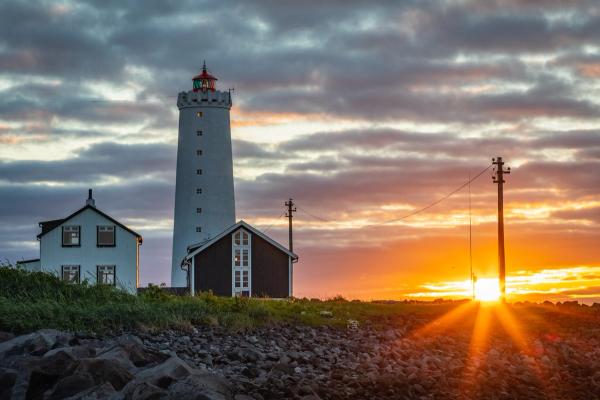
Where to Stay: Reykjavik Eco-Campsite
Just 6 kilometers (3.7 miles) from Grótta Lighthouse, Reykjavik Eco-Campsite is a great base for campervan trips inside the country’s capital. It’s open all year for campervans and caravans, but the area for tents is only available between May and September. It features modern facilities, such as toilets, showers, electricity hookups, laundry, and a communal kitchen. There’s even Wi-Fi throughout the whole camping ground. Reykjavik Eco-Campsite combines sustainability with convenience.
It’s located in a green area in eastern Reykjavik, with easy access to the city’s cultural landmarks, restaurants, and shops.
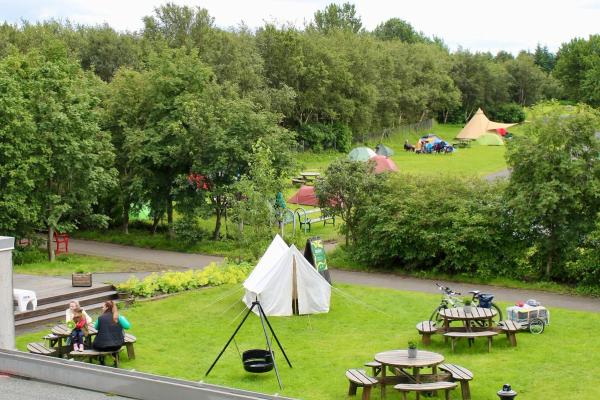
2. Dyrhólaeyjarviti
Perched on the cliffs of Dyrhólaey, on Iceland’s south coast, Dyrhólaeyjarviti is a striking square tower with a red lantern, built in 1927. Dyrhólaey means “door hill island,” and it’s in front of an arch-shaped rock formation carved by the sea. The lighthouse overlooks black sand beaches, jagged sea stacks, and the vast Atlantic, offering amazing views of the surrounding landscapes.
This area is one of the best in the country for birdwatching, and puffins can be seen in large numbers in the summer months. It’s a must-visit for those exploring the south coast and the most iconic landscapes in the region.
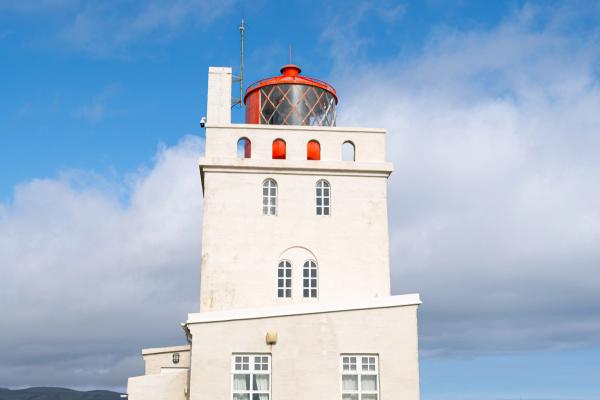
Where to Stay: Vík Campsite
Vík i Mýrdal is one of the most important towns in South Iceland, and it’s just 6 kilometers (3.7 miles) from Dyrhólaeyjarviti. And it has its own camping ground. Open from May to October, it offers tent and campervan pitches with access to clean restrooms, hot showers, and a shared kitchen. There are shops, restaurants, and gas stations in Vík, so it’s perfect for restocking.
Reynisfjara, one of the most iconic and photographed black sand beaches in Iceland, is just outside the town. It’s a striking beach framed by hexagonal basalt columns. From there, you can also see the impressive Reynisdrangar sea stacks.

3. Svortuloft Lighthouse
The Snæfellsnes Peninsula is one of the most varied regions in Iceland. It’s located in West Iceland, and it’s often nicknamed “Iceland in miniature” because it has a bit of everything that has made this country famous. At the westernmost point, we can find Svortuloft Lighthouse, a vibrant orange beacon against the dark cliffs of Látrabjarg. Built in 1931 and powered by solar energy, this 12-meter tower is essential for navigating this coast.
It’s in a remote location that offers breathtaking views of the North Atlantic and the dramatic volcanic landscape around it. In summer, bird lovers can find puffins, guillemots, and razorbills here. The lighthouse’s bold color and wild surroundings make it stand out as one of the best lighthouses in the country.

Where to Stay: Hellissandur Camping Ground
Hellissandur Camping Ground is 25 kilometers (15.5 miles) from Svortuloft Lighthouse, and is a peaceful retreat open from May to September. Opened in 2011, this campsite is located in the middle of a beautiful lava field. It has a common area with toilets, showers, and sinks. There are also several trails from the camping ground to explore the area.
The campsite is operated by the information center in Snæfellsbær, which is located in the next town, Ólafsvík, about 9 km from Hellissandur.
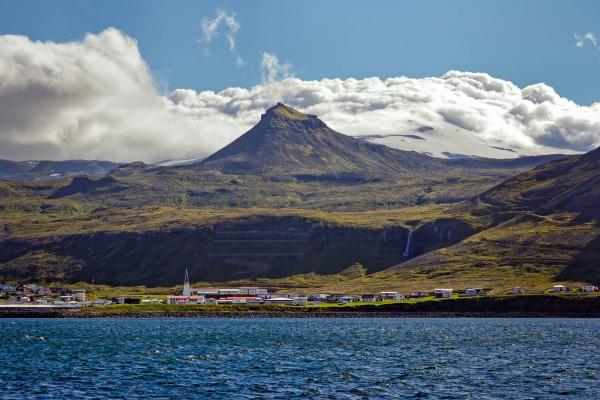
4. Reykjanesviti
On the southwestern corner of Iceland, Reykjanesviti, the country’s oldest lighthouse, stands proudly. This lighthouse is on the Reykjanes Peninsula. It’s 31 meters tall, featuring a classic white tower and a red cap. First built in 1878 and rebuilt in 1929 after an earthquake, it serves as a navigation aid in this part of Iceland.
It’s surrounded by lava fields, and it’s just by the geothermal area of Gunnuhver, full of hot springs, boiling mud pools, and steaming vents. It even has the largest mud pool in Iceland.
From the lighthouse, there are great panoramic views of the rugged coastline and the Reykjanestá Cliffs.
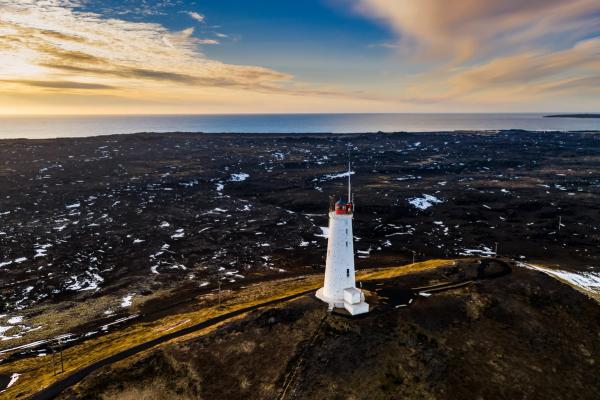
Where to Stay: Grindavík Camping Ground
Located on the southern shore of the Reykjanes Peninsula is Grindavík, a town that has its own camping ground. It’s just 10 kilometers (6 miles) from Reykjanesviti and is normally open between March and November, but the exact dates may change from year to year, so always check before traveling.
This well-equipped site offers tent and campervan pitches with modern facilities, including hot showers, toilets, and a communal kitchen. It’s also one of those camping grounds that, because they are inside a town, become a convenient base, as it has access to local shops and restaurants. On top of that, it’s the closest campsite to the Blue Lagoon, making it an excellent opportunity to enjoy a geothermal bath in the most famous spa in the country.

5. Dalatangaviti
We go now to the other side of Iceland, to the East Fjords. This region is one of the least visited in the country, but it’s really beautiful. Here is Dalatangaviti, a nice little lighthouse near Mjóifjörður. It was built in 1917 and then relocated in 1959; its design is as charming as it can be. It resembles a traditional Icelandic house, painted white with a black roof, and features a bright red lantern room. It creates a nice contrast with the dramatic fjord landscape.
It’s not easy to get to the lighthouse; the route is an adventure in itself. It’s necessary to drive on a rugged gravel track, so you’ll need a 4x4 campervan to get there. Having said that, the views and the sense of solitude once you get there are just unparalleled.
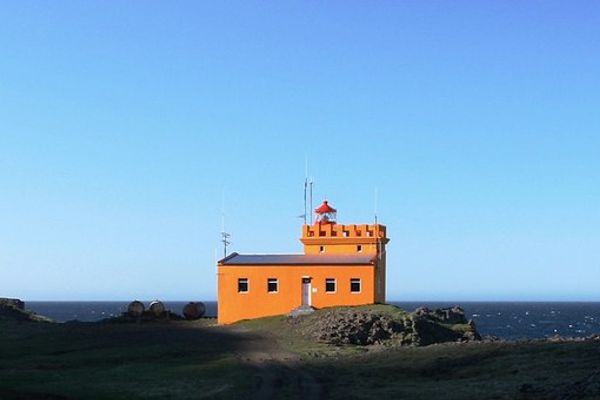
Where to Stay: Sólbrekka and Seyðisfjörður Campsite
For this one, we’re proposing two options to stay. Both of them are really close on a straight line, but one requires either a detour or driving on a quite complicated road.
The closest one is Sólbrekka, just 15 kilometers (9 miles) from Dalatangaviti. It has a camping area, a guesthouse, and cottages for rent. The campsite and guesthouse are open from June to September, but the cottages are available all year. The camping area has toilets with showers, an outdoor bench and table, free Wi-Fi, a washing machine, a tumble dryer, and electricity.
The other option is Seyðisfjörður Campsite, which is 35 kilometers (21.7 miles) away, but depending on the conditions, you may need to make 80 kilometers (50 miles) to get there from Dalatangaviti. Open from May to September, it offers tent and campervan pitches, along with modern facilities including hot showers, a kitchen, and Wi-Fi. Located in the vibrant village of Seyðisfjörður, it’s near shops and cafés, making it a great base for exploring the East Fjords.
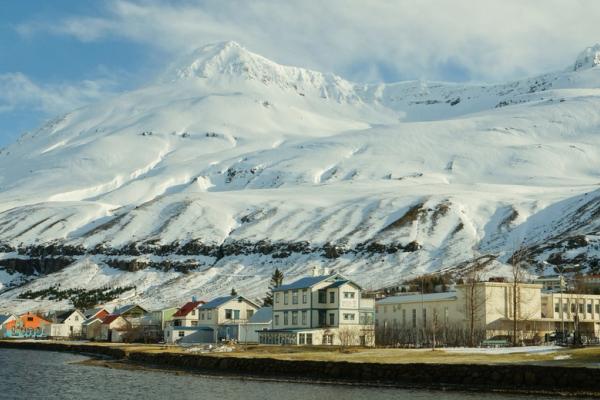
6. Akranes Lighthouse
In the industrial town of Akranes, 50 kilometers (31 miles) north of Reykjavík, we can find not one but two lighthouses standing together. There’s the Old Akranes Lighthouse, built in 1918, and the much bigger current Akranesviti, from 1947. The latter houses a museum and photography exhibitions, and visitors can climb to the top for sweeping views.
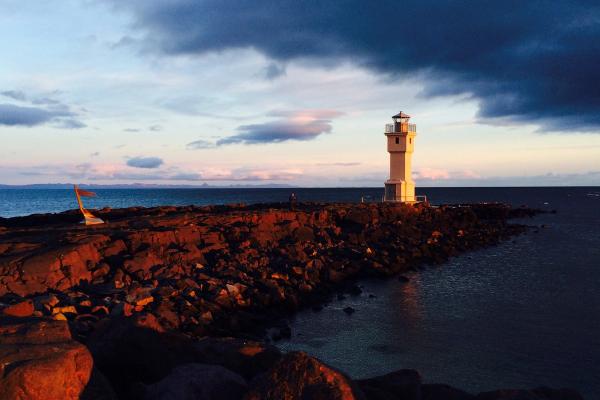
Where to Stay: Akranes Campsite
Just 2 kilometers (1.2 miles) from Akranes Lighthouse, on the other side of town, Akranes Campsite is open from May to September. This family-friendly site offers tent and campervan pitches with clean facilities, including showers, toilets, and a communal kitchen.
Its proximity to Akranes’ town center provides easy access to shops and restaurants. It’s just by the coast, giving the opportunity for walks and birdwatching. The campsite’s grassy fields and relaxed atmosphere make it an ideal spot for exploring the lighthouse and the surrounding area.
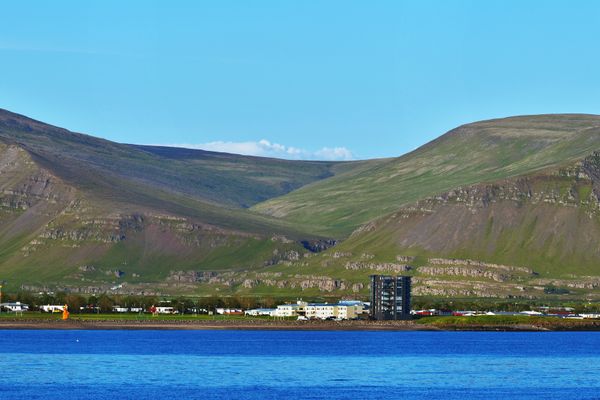
7. Knarraros Lighthouse
Near the town of Stokkseyri, in southwest Iceland, Knarraros is one of the most original lighthouses in Iceland. It’s, in fact, considered to be an architectural masterpiece. Designed by Guðjón Samúelsson in 1939, its 26-meter tower is a mix of functionalism and Art Nouveau. It looks more like a sculpture than a lighthouse.
It offers stunning views of the North Atlantic Ocean, and the area is teeming with birds.

Where to Stay: Stokkseyri Campsite
Located 3 kilometers (1.9 miles) from Knarraros Lighthouse, Stokkseyri Campsite is open from May to September. It’s small but has all the basics needed for a campervan stay, with toilets, showers, and a shared kitchen. As it’s really close to the village of Stokkseyri, with shops and restaurants.
This town is renowned for its fresh seafood. It’s also a great place to take a stroll by the seafront. It’s not far from Selfoss, one of the main cities in South Iceland.

8. Bjargtangar Lighthouse
This lighthouse is as remote as you can get. Located on the Látrabjarg cliffs in the Westfjords, Bjargtangar Lighthouse marks Europe’s westernmost point. Built in 1948, this simple white tower overlooks the vast North Atlantic and the cliffs, home to millions of seabirds, including puffins. Standing there, you feel like you’re at the edge of the world, with nothing in front of you but the endless sea.
The Westfjords are one of the most remote and isolated regions in Iceland, and many tourists skip it. Traveling here may take a while, but it’s worth it.
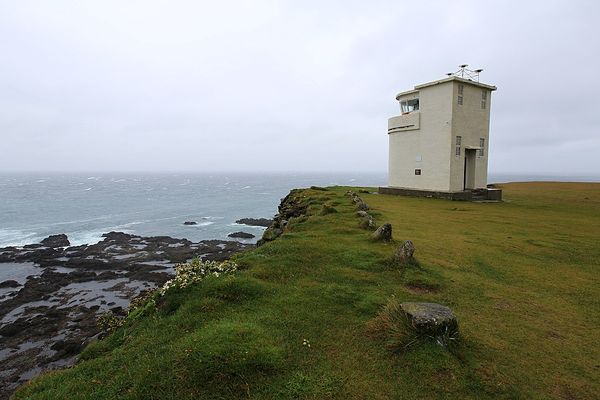
Where to Stay: Breiðavík við Látrabjarg
Just 13 kilometers (8 miles) from Bjargtangar Lighthouse, Breiðavík við Látrabjarg is a campsite that opens from June to August. It offers tent and campervan pitches and has toilets, showers, a washing machine, cooking facilities, and Wi-Fi. It’s in front of Breiðavík Beach, a long and beautiful golden sand beach.
From the campsite, take a walk to Breiðavíkurkirkja, a small white and red church, a perfect example of Icelandic traditional architecture. The views from there are astonishing.
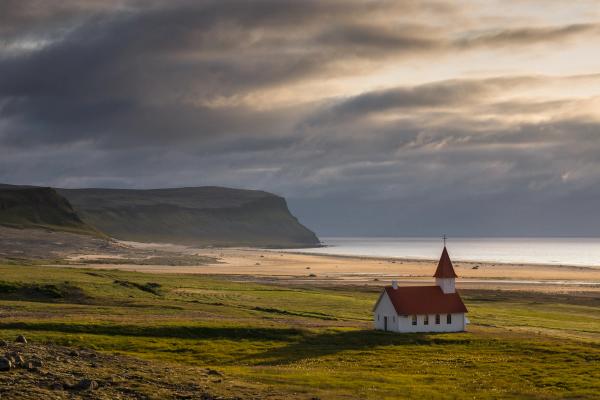
9. Súgandisey Island Lighthouse
Originally located at Grótta in Reykjavik, the Súgandisey Island Lighthouse was relocated to Stykkishólmur’s harbor in 1931. This small, white tower offers panoramic views of Breiðafjörður Bay and the surrounding mountains. This red beacon is on a small hill by the sea, and from there you can get 360-degree views of this charming fishing town and the Snæfellsnes Peninsula.

Where to Stay: Stykkishólmur Camping Ground
This campsite is just on the other side of the town, barely 1 kilometer (0.6 miles) from Súgandisey Lighthouse, and it’s open from May to September. This well-maintained site offers tent and campervan pitches with modern amenities, including hot showers, toilets, electricity, and a communal kitchen.
This campsite is ideal for those seeking a basic camping ground with easy access to all the necessary services for a campervan trip. There’s also a 9-hole golf course next door where you can rent clubs.

10. Garðskagaviti
Not far from Keflavík International Airport, on the Reykjanes Peninsula’s northern tip, there’s Garðskagaviti, a picturesque duo of lighthouses. One is rounded and white, built in 1944, and stands at 32 meters (105 feet), being Iceland’s tallest lighthouse. The other one is square, white with two wide red stripes, and was erected in 1897.
Garðskagi is the tip of the peninsula, a green area surrounded by lava fields. It’s a premium site for bird-watching, where whales can also often be seen from the coast.
The big lighthouse has two exhibitions, Northern Lights Show and Whale Show, and fantastic views from the top balcony.
Where to Stay: Garðskagi Camping and Sandgerði Campsite
Again, we’re listing two options here. The first one is Garðskagi, and it’s just there. In fact, it’s between the two lighthouses, so you can’t get any closer. It’s open all year and offers tent and campervan pitches with basic facilities like toilets and showers. Its unique location offers great views and excellent bird-watching opportunities.
The other option is Sandgerði Campsite, located in the town of the same name. It’s also known as the airport camping for its proximity to Keflavik International. It’s 6 kilometers (3.7 miles) from the lighthouses and also open year-round. It has very good facilities, including toilets, showers, electricity, a washing machine, a playground for kids, and Wi-Fi. It also has cottages that can be rented.
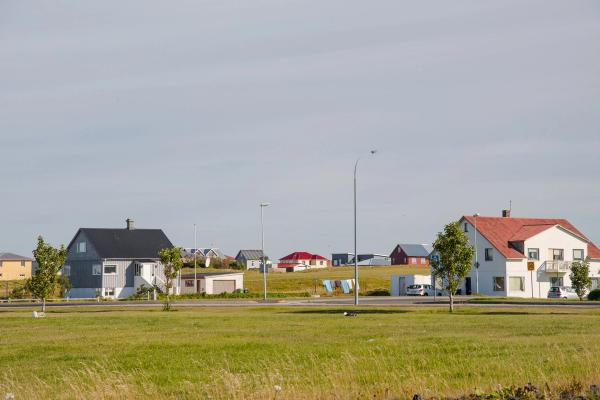
Special mention: The spectacular Þrídrangaviti
The most spectacular lighthouse in Iceland is, without a doubt, Þrídrangaviti. It’s located on top of the tallest of three sea stacks, in the middle of the ocean. The reason why we haven’t listed it here before is that it’s impossible to go there in a campervan. It’s in the middle of nowhere, and you can only get there by boat from the Westman Islands (Vestmannaeyjar). And only workers can access the lighthouse.
To get to the Westman Islands, you need to take the ferry from Landeyjahöfn, on the south coast. Once in Heimaey, the main island of the archipelago, you have two options: Þórsvöllur Campsite and Vestmannaeyjar Camping ground.
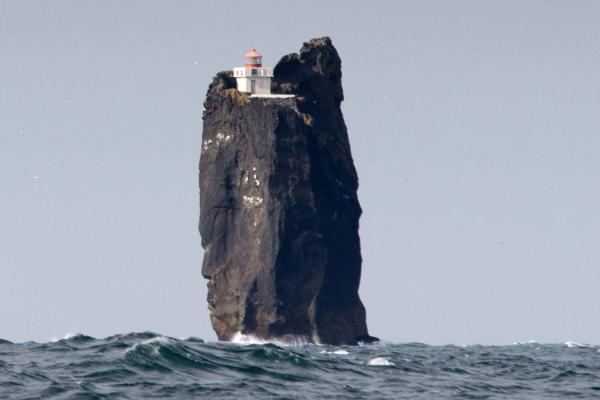
Travel Tips
- Check Tide Times for Grótta: The causeway to Grótta Lighthouse is only accessible at low tide, so plan your visit accordingly.
- Pack for Variable Weather: The weather in Iceland changes constantly. Lighthouses are all by the coast, where the conditions are even more variable. It’s crucial to dress in layers to adapt to the temperatures and always wear a waterproof outer layer to deal with the rain, wind, and ocean spray.
- Consider Renting a 4x4 Campervan for Remote Areas: The roads leading to Svortuloft and Dalatangaviti can be rough. Having a 4x4 vehicle is necessary to get to these places or if you’re planning to drive on F-roads during your trip.
- Bring Binoculars: Many lighthouses, like Bjargtangar and Dyrhólaeyjarviti, are birdwatching hotspots. Bring a pair of binoculars to follow the action.
- Book Campsites Early: Popular sites like Reykjavik Eco-Campsite and Vík Campsite fill up quickly in summer. Reserve in advance.
- Respect Nature Reserves: Areas like Grótta and Látrabjarg are protected. Stick to paths and don’t litter to preserve the environment.
Conclusion
Iceland has a deep and strong connection with the sea, and the many lighthouses present on the island are a testament to it. Many of them are much more than just beacons for navigation. Some are iconic buildings, others are part of a beautiful natural area. All the ones listed here are also in the middle of amazing places, each viti offers a unique perspective on Iceland’s landscapes. Rent your campervan, hit the road, and discover these fantastic sites.

